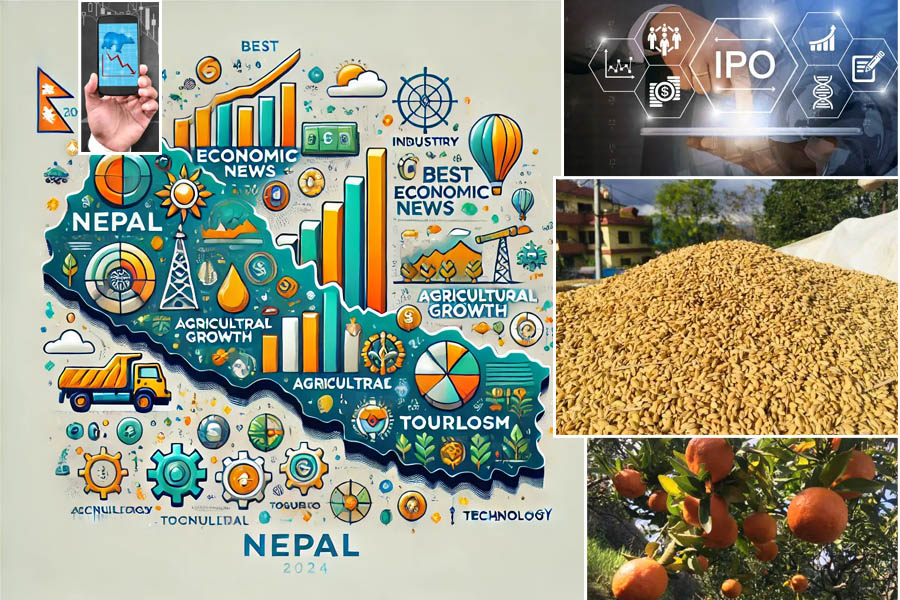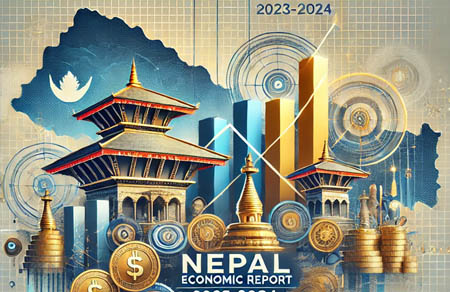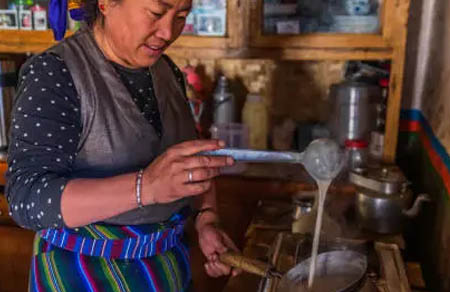
Six Best Economic News Trolling Nepal Right Now
December 23, 2024A symphony of hope and hurdles shaping the Himalayan nation's financial future
The banking sector in Nepal is under pressure, with a cautious lending environment and deposits yielding minimal returns. This hesitation stems from economic uncertainties, creating challenges for businesses and individuals seeking financial support.
Nepal’s export-import gap remains significant, but there’s a silver lining—economic activities are gradually improving, showcasing a slow but steady recovery. Foreign aid and remittance continue to play a vital role in stabilizing Nepal’s economy, providing much-needed resilience.
Tourism is gaining momentum, bolstered by the opening of new international airports and the emergence of thriving, newly developed cities. These developments are not only driving economic activity but also paving the way for Nepal to enhance its global appeal.
Hydropower stands as a beacon of progress, demonstrating Nepal's potential for self-reliance and growth. Despite the challenges, the sector continues to grow, showcasing the country’s ability to leverage its natural resources for economic advancement.
Dive into the six plus trending economic stories that are shaping Nepal’s narrative right now and discover how progress and challenges intertwine in this dynamic landscape.
The Flow of Excess Liquidity
The rivers of capital in Nepal's banking sector flow abundantly, yet the fields of investment remain barren. With a staggering liquidity surplus of over NPR 7 trillion, banks find themselves with an abundance of unutilized funds. Despite historically low interest rates of just 4%, businesses hesitate to borrow. Entrepreneurs cite systemic challenges: unstable politics, unreliable infrastructure, and bureaucratic delays.
The government’s ambitious target of 6% economic growth and a 12.5% private sector credit expansion seems elusive. Non-performing loans (NPLs) are on the rise, highlighting the need for a bold government strategy to restore trust and foster investment opportunities.
Rasuwagadhi Hydro Power Plant Successfully Completes Trial Production, Generating 52 MW
The Rasuwagadhi Hydro Power Plant, located in the northern part of Rasuwa in Timure, has successfully completed its trial production, generating 52 MW of electricity. The power plant, situated in the coastal area of Bhotekoshi within Wards No. 1 and 2 of Gosainkunda Rural Municipality, operates with three 33/33 MW capacity machines. Project Chief Satyaram Jyakhwa confirmed that despite the reduced river flow during the colder season, the first trial production was successful. The power plant is expected to operate at full capacity during the rainy season.
With an estimated cost of Rs 18.69 billion, the Rasuwagadhi Hydropower Project has faced delays due to challenges such as fuel shortages, the 2015 earthquake, and natural disasters like floods in Bhotekoshi. However, all three turbines are now fully operational, generating 613.875 million units of electricity annually, contributing Rs 3.25 billion in revenue. The project, funded through a combination of loans and contributions from the Employees Provident Fund, Nepal Electricity Authority, and local bodies, was built by Rasuwagadhi Hydropower Company, a sister organization of Chilime Hydropower Company.
Nepal Sees 237% Surge in Foreign Aid Commitments in Current Fiscal Year
Nepal's Ministry of Finance has reported a substantial increase in foreign aid commitments from development partners, reaching Rs 202.4 billion by the first week of Poush in the fiscal year 2081/82. This marks a 237% rise in commitments compared to Rs 59.98 billion during the same period last year. Notably, foreign grants have grown by 153%, while foreign loans have surged by 280%, reflecting a strong boost in international support for Nepal's development projects.
The overall foreign aid received this year has also risen by 30.3% from the previous fiscal year, with Rs 44.8 billion utilized for various development and infrastructure projects. This includes Rs 6.75 billion in foreign grants and Rs 37.33 billion in loans, which have been directed towards enhancing Nepal's construction and development sectors, as confirmed by Finance Ministry spokesperson Mahesh Bhattarai.
Paddle Forward: Dragon Boat Race to Propel Pokhara Tourism
The second Nepal-China Friendly Dragon Boat Race is set to take place in Pokhara on Poush 14 and 15, featuring 20 teams from Nepal, China, and Singapore. This event, aimed at promoting Nepal's tourism, is jointly organized by the Gandaki Province Government, Pokhara Metropolitan City, the Chinese Embassy in Nepal, and the Nepal Tourism Board, with support from various local organizations. The competition will be held at Fewa Lake and includes two race distances of 200 meters and 500 meters.
The organizers have announced attractive prizes for the winners. The first-place winners in both race distances will receive $5,000 each, while the runner-ups will take home $2,000. The third-place winners will be awarded $1,200, and the remaining 17 teams will receive $500 each as a token of appreciation. This initiative aims to encourage participation and highlight Pokhara as a prime tourist destination.
Wang Xin, Deputy Chief of Mission at the Chinese Embassy in Nepal, emphasized the significance of the Dragon Boat Race in fostering friendly ties between Nepal and China. He highlighted China's commitment to supporting Nepal's tourism development, citing the growing number of Chinese tourists visiting Nepal annually. Executive Chief of the Nepal Tourism Board, Deepak Raj Joshi, also underscored the importance of the Chinese market in promoting Pokhara's tourism potential.
The Dragon Boat Festival, recognized by UNESCO as an intangible cultural heritage since 2009, has deep cultural significance in China. Celebrated on the fifth day of the fifth month of the lunar calendar, the festival involves joyous activities ranging from boat racing to traditional feasts. The festival has a strong tradition in Chinese provinces, with celebrations spanning 3 to 7 days. The event in Pokhara reflects this vibrant heritage, showcasing the cultural collaboration between Nepal and China.
Tourism leaders see this event as more than a race—it is a bridge, connecting Nepal's hospitality to a global audience. With over 92,000 Chinese tourists visiting Nepal in 2024, such initiatives strengthen ties and chart a course for mutual prosperity.
A Beacon of Power: Share Agreement for Myagdi Hydropower
Citizens Investment Fund and Myagdi Hydropower Limited have signed a share guarantee agreement to facilitate the issuance of shares worth Rs 474 million. Under this agreement, shares will be issued at the rate of Rs 100 per share, with a total value of Rs 474 million. The signing ceremony, held on Sunday, was attended by the Fund's Executive Director, Parbat Kumar Karki, and Myagdi Hydropower Chairman, Bharat Prasad Nepal. This agreement reflects a collaborative effort to boost investment opportunities in Nepal's hydropower sector.
The agreement will remain valid for six months from the date of signing, providing Myagdi Hydropower with the assurance to proceed with its share issuance plan. This initiative is expected to strengthen financial resources for the company and support the development of hydropower infrastructure in Nepal, contributing to the nation's sustainable energy goals.
Scaling Mountains: The Kathmandu-Kerung Railway Saga
Amid towering peaks, Nepal dreams of a railway connecting Kathmandu to Kerung. The feasibility study inches forward, with 98% of the terrain demanding tunnels and bridges. The estimated cost of Rs 271.368 billion looms large, a reflection of both ambition and challenge.
This project symbolizes Nepal's aspiration to integrate with global trade networks. Analysts emphasize the need for transparent planning, international collaboration, and sustainable financing to ensure this dream does not derail under its own weight.
Electricity Worth Rs 13.4 Billion Exported to India in Five Months
Nepal Electricity Authority (NEA) exported surplus electricity worth Rs 13.4 billion to India within the first five months of the fiscal year 2081/82. A total of 1.76 billion units of electricity were sold during this period, averaging Rs 7.39 per unit. These transactions took place through the Indian Energy Exchange (IEX) and bilateral agreements with Indian states like Haryana and Bihar, generating Rs 8.15 billion in revenue. Notably, the highest monthly export was recorded in Shrawan, worth Rs 4.15 billion, while Mangsir saw the lowest at Rs 281.4 million.
The exports faced disruptions due to natural disasters affecting the Upper Tamakoshi Hydropower Station, which reduced electricity production during the later months of the year. Floods and landslides in Asoj damaged not only the 456 MW Upper Tamakoshi station but also the Kabeli Corridor transmission line. These setbacks impacted the overall export target, necessitating imports earlier than anticipated due to reduced hydropower output in the dry season. Despite these challenges, NEA's efforts to restore operations, including the renovation of Upper Tamakoshi by Poush 10, reflect its commitment to stabilizing electricity trade.
With an export target of Rs 30 billion for this fiscal year, the NEA continues to navigate hurdles while leveraging its approval to sell 941 MW of electricity to the Indian market. Last year, Nepal transitioned from a net importer to a net exporter, achieving a trade surplus of Rs 130 million in electricity. However, the onset of winter signals a temporary shift to imports as hydropower production declines. Electricity exports are expected to resume as water flow increases, reaffirming Nepal's potential as a sustainable energy exporter.
Trade Imbalance: Exports and Imports
The country's export trade has shown significant improvement in the first five months of the current fiscal year 2024/2025. Exports have risen by 16.54 percent, reaching a total of Rs 73.65 billion, which is 16.5 percent higher compared to the same period last year. In the first five months of the previous fiscal year, the total export value was Rs 63.20 billion. This growth marks a substantial increase in Nepal's export activity, with a noteworthy boost of Rs 20.98 billion over the past month alone. Exports in the first four months stood at Rs 52.67 billion, demonstrating a significant rise as the year progressed.
Imports, however, have also risen during this period, with goods worth Rs 661.48 billion entering the country, marking a 3 percent increase compared to the previous year. In the first five months of last year, goods valued at Rs 642.20 billion were imported. Nepal's foreign trade involves transactions with 149 countries, with India leading the import-export activity. The total value of imports from India stands at Rs 410.55 billion, while exports to India have reached Rs 51.10 billion. China follows in second place for imports, with a total of Rs 131.37 billion, while exports to China amounted to Rs 1.74 billion.
The US, Germany, and the UK also play significant roles in Nepal’s export market. Exports to the US amounted to Rs 7.34 billion, securing the second position among the highest export destinations. Germany and the UK followed with Rs 1.96 billion and Rs 1.49 billion in exports, respectively. Soybean oil, cardamom, sunflower oil, carpets, and tea are the leading export items that have contributed to this positive growth in trade. Soybean oil exports have notably surged, with a total of Rs 8.36 billion exported during the first five months, primarily to India. The increase in Indian customs duties on oil imports has spurred Nepali oil producers to focus on exports rather than domestic sales.
Cardamom ranks second in exports, with Rs 3.46 billion worth exported. Sunflower oil follows in third place, amounting to Rs 2.98 billion, with the majority going to India. Additionally, carpet exports have been encouraging, with Rs 2.83 billion worth shipped overseas. The tea industry also saw growth, with black tea exports totaling Rs 2.57 billion, primarily destined for the Indian market, though there is growing demand for Nepali Orthodox tea in Europe and the US.
Nepali exports also include yarn, steel, iron, juice, and jute, with values of Rs 2.39 billion, Rs 2.11 billion, Rs 2.38 billion, and Rs 2.27 billion, respectively. These products are being exported to a range of countries, adding to Nepal’s export diversity. However, imports of petroleum products continue to dominate, with diesel imports worth Rs 42.17 billion and petrol worth Rs 26.45 billion. Additionally, Nepal has imported significant quantities of LP gas, aviation fuel, pharmaceuticals, steel, rods, and mobile phones, with respective values of Rs 24.22 billion, Rs 8.14 billion, Rs 12.84 billion, Rs 11.91 billion, and Rs 10.35 billion.
The ongoing efforts to promote exports through diversification, coupled with the introduction of new trade agreements and partnerships, will be essential to addressing the trade imbalance. As Nepal continues to export key items such as tea, carpets, and agricultural products, the hope is that these efforts will strengthen the country’s economic standing in the global market. However, a sustained focus on increasing export volumes and reducing import dependency will be critical for Nepal to achieve a more balanced trade situation in the coming years.
While the increase in exports is encouraging, the widening trade gap remains a concern. Imports have surged faster than exports, leading to a trade deficit. The import of petroleum products, in particular, continues to strain the country’s foreign exchange reserves. Despite the positive growth in export sectors such as agriculture and manufacturing, Nepal’s reliance on imported goods, especially petroleum and essential materials like steel, remains a significant challenge to the balance of trade.
To The End
As Nepal stands at the crossroads of opportunity and challenge, its economic landscape tells a tale of resilience. From unutilized liquidity to ambitious infrastructure dreams, every statistic is a thread in the fabric of a nation's future. Hydropower and tourism shine as pillars of hope, while the trade deficit and investment inertia remind us of the work yet to be done.
With strategic policies, collaborative efforts, and unwavering determination, Nepal can transform these challenges into stepping stones toward economic prosperity. The Himalayan nation has the potential to not just survive but thrive, inspiring its people and the world with its journey of growth and innovation.
Nepal’s Economic Landscape: Trends and Insights!
Nepal’s economy continues to thrive through key exports such as tea, carpets, and agricultural products. With the tourism sector set to achieve new milestones, the country is poised for even greater economic growth in the coming years. As Nepal strengthens its position in global markets, the outlook for its economic future looks promising.
Subscribe for Expert Economic InsightsStay updated with the latest developments in Nepal's economy and gain expert analysis on its global trade impact.
Read More From Us
- 🌟🌟🌟🌟🌟 For more International Breaking News visit us at International News
- 🌟🌟🌟🌟 For More Russia-Ukraine War updates, click here
- 🌟🌟🌟🌟🌟 For more International Trade Business news, hit here
Tags: #NepalEconomy #EconomicNews #BankingLiquidity #TourismNepal #ForeignAid #TradeImbalance #InfrastructureProjects #HydropowerNepal #Nepal2024 #GlobalInsights #GlobalPostHeadline
Thank you for reading: globalpostheadline.com





